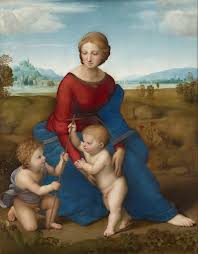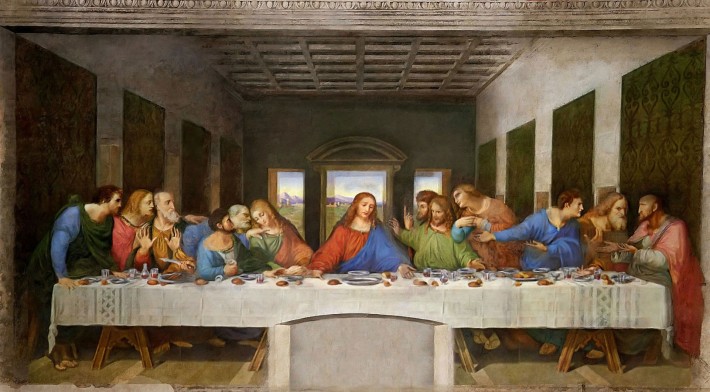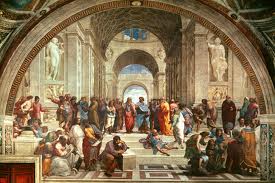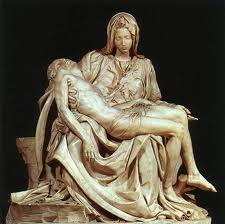Background of St. Peters Basilica
St. Peters Basilica is a Late Renaissance Church located in Vatican City. The building of the church started in 1506 and was not completed until the early 16th century. The St. Peters Basilica was built with both renaissance architecture and baroque architecture. The Dome and geometric figures are very Greek and Rome styled. Although many people worked very hard to build the St. Peters Basilica, there were a few who contributed a lot. Donato Bramante started to build in the 15th century until he passed away. Upon his death, Michaelangelo was made chief of the architecture and building of the church. Raphael also contributed a lot to the St. Peters Basilica.
Interpretation of St. Peters Basilica
The architecture of the St. Peters Basilica related a lot to harmony, human scale, and proportion. Everything followed geometric forms. These forms included mostly squares, rectangles, and circles. Everything was made out of brick or stone, unlike the concrete used with the Romans. Notice that the windows are doors are mostly arched or rectangular. The roofs are also mostly domed, like the dome in the center of the St. Peter Basilica. A lot of hard work and dedication went into creating the St. Peter Basilica. It’s amazing form and architecture make it not only beautiful to look at, but extraordinary to think that things this amazing built in the 15th century.
Background Information of Madonna in the Meadow
Madonna in the Meadow, another one of Raphael’s famous paintings, is a painting of Madonna (Virgin Mary), Christ (Jesus), and St. John the Baptist. The painting’s scene takes place in a Tuscan scene. St. John the Baptist is the cousin of Christ. He is also a patron of Florence, making his presence very appropriate in this Florentine setting. Although there are many paintings of Mary and Christ, this painting is extra significant because of the meaning that St. John the Baptist is able to bring into the painting.
Interpretation of Madonna in the Meadow
In Madonna in the Meadow, St. John the Baptist, Christ’s cousin, is holding a cross. However, he is not the only one holding it. Christ is also holding onto the cross of St. John with his hand. His grasp on the cross foreshadows the events of Christ and the Cross in the future. With Madonna smiling and her hands wrapped gently around Christ, the mood of this painting starts to shine through; peacefulness. Raphael arranged the figures in this painting in a pyramidal composition, something that he had picked up from Da Vinci. Overall, this painting is enjoyable and not like most of the other paintings of the Renaissance. Instead of mystery and death and darkness, this painting shows peacefulness and happiness.
Background information of Lady with an Ermine
Another painting by the famous, Leonardo Da Vinci, The Lady with an Ermine is one of Da Vinci’s best known works of art in the Italian Renaissance. This portrait was painted in Milan, Italy when Da Vinci was working fro Duke Ludovico Sforza. Cecilia Gallerani, the woman in this portrait, was the Duke’s mistress. The ermine (weasel) in this painting provides many meanings of this portrait. This painting is one of the few authentic panel paintings of Da Vinci’s that survived through the Renaissance. This portrait is an image of high elegance that starts to reveal Da Vinci’s creative perspective.
Interpretation of Lady with an Ermine
The ermine in the late 15th and early 16th centuries was a highly valued creature. It provides multiple meanings of the portrait. The Greek word for ermine is galee, playing on Cecilia’s last name, Gallerani. The ermine also represents Cecilia’s character. Legend says the ermine is too particular, fussy, and picky to dirty its own fur. So, the ermine is representing Cecilia’s personality and identity. This painting suggests Cecilia’s high elegance and wealth. Da Vinci made it important to clarify her outside beauty by her elegance and wardrobe, and her inside beauty by the Ermine. Da Vinci has again shined his creativity through his paintings. The high contrast in this painting and the use of the Ermine support that this painting is most definitly from the Renaissance.
Background information of Madonna and Child
Madonna and Child is one of the many paintings of Mary and Jesus that Giovanni Bellini has created. Madonna and Child is simply a picture of Madonna, also know as Mary the Virgin, and her child, Christ, also known as Jesus. Madonna is on a kneel in this painting holding her son. In the background, there are two cities. This painting is dated from 1488, making Madonna about 58 years of age when she completed this painting.
Interpretation of Madonna and Child
In the painting, Madonna and Child, Madonna is holding her son, blessed but still confused on why she was the one chosen to carry the The Lord’s son. In front of Madonna and Jesus, there is a pear. The pear is a key example of symbolism in this painting. The pear is placed in front of Madonna as an illusion. An illusion that Madonna, the virgin, and her new role as Eve, redeem humanity with Christ in her arms. There are many other paintings based off of Madonna and Christ from the Renaissance. This painting was placed on display in 1579, 91 years after she completed it, and 63 years after her death in 1516. Like many other artists of the Renaissance, Giovanni Bellini used detail through the human form. The Child’s body in this painting is so realistic, as Madonna is as well. By the way the human bodies were drawn and painted, it’s no question this is a painting from the Italian Renaissance.
Background Information for The Last Supper
The Last Supper, by Leonardo Da Vinci was one of the most famous paintings of the Renaissance because of its importance. The Last Supper is a painting representing the well known Bible Story of Jesus and his disciples. Leonardo Da Vinci began working on this painting in 1495 and finally completed it in 1498. The painting is very big, measuring 180 inches by 350 inches. It covers an entire wall in the Santa Maria Delle Grazie in Italy. Da Vinci recreated this painting from a painting that was completed 50 years before him.
Interpretation of The Last Supper
The Last Supper is all about a story. The last supper was literally Jesus’s last supper with his 12 disciples before he was crucified. Jesus was convinced that one of his disciples was going to betray him. When Jesus tells his disciples this news, this painting happens. This painting represents all the disciples reactions when Jesus announces someone will betray him. Not one emotion was used twice in this painting. The detail Da Vinci was able to use in the disciples faces is extraordinarily clear and convincing. Da Vinci was able to use perspective in this painting to make it look more realistic opposed to the painting before this that was very flat. Da Vinci did a great job of recreating The Last Supper during The Italian Renaissance.
Background Information for The Vitruvian Man
The Vitruvian Man, by Leonardo Da Vinci, also known as the canon of properties and proportions of man, is based off of human proportions and observations. Da Vinci’s main source of inspiration for this drawing came from the work of Vitruvius, a well known roman architect. Da Vinci’s background in anatomy and geometry gave him the ability to blend science and art to create this masterpiece.
Interpretation of The Vitruvian Man
Although Da Vinci’s basis for this drawing was from the work of Vitruvius, the sketch goes way beyond the mathematical and geometric figures of the human body. Da Vinci is able to shift the height, length, and width proportionally to a human figure. Notice that this picture has one abdomen and one head, but four legs, and four arms. With the added arms and legs and the shifted limbs, the drawing allows 16 different poses to be observed. The Vitruvian Man shows the mix between art and science and the brilliant way Leonardo Da Vinci was able to combine his observations and knowledge to create one of the most famous drawings of not only the Renaissance, but all time.
Background Information for The Arnolfini Marriage
The Arnolfini Marriage, by Jan Van Eyck, was an oil painting from the Northern Renaissance. This painting represents Giovanni Arnolfini and his wife, Giovanna Arnolfini marrying one another. This painting is considered to be one of the most complex paintings in western art for its unusual geometric perspective. This portrait takes place in their home in Bruges, Netherlands during the 15th century. This painting is also known as the Arnolfini Portrait, The Arnolfini Wedding, and The Arnolfini Double Portrait.
Interpretation of The Arnolfini Marriage
In this painting, Giovanni is dressed in all dark colors. During this time period, dark colors were respected at weddings. His wife, Giovanna, is wearing a heavy robe giving her a swollen appearance. This is symbolizing the child bearing part of the female figure. Ironically, Giovanna never had any children. Above the mirror on the back wall is writing. This writing is actually a signature of two witnesses of Giovanni and Giovanna’s wedding. Even though it was allowed to be married in their chamber/home, two witnesses were mandatory for it to be official. This painting is all about symbolism. Jan Van Eyck brilliantly made everything in this painting a symbol to represent their wedding day. This type of art technique leaves the observer left with questions.
Background Information for The School of Athens
The school of Athens, by the Italian Renaissance artist, Raphael, is known to be Raphael’s absolute “Masterpiece”. The School of Athens represents all of the greatest scientists, philosophers, and mathematicians gathering to share and learn from one another. However, the ironic part of this painting is that it is unrealistic. All of the people in the painting lived during different time periods, making this piece of artwork a little bit misleading. In the School of Athens, all of these great men are reunited under one roof. Some of the men painted in this picture include Plato (philosopher), Aristotle(Philosopher), Pythagoras(mathematician), and Raphael himself.
Interpretation of The School of Athens
The School of Athens overall symbolizes knowledge and education. This work of art was very different from all the other arts during the Renaissance. Most art during the Renaissance was based solely off of religion and the ideas and beliefs of church. In this painting, Raphael is able to combine old Greek life with new Greek life philosophers and ideas. This painting is admirable because of it’s great detail. In a close enough view of the picture, each person in the painting is making expressions that make the painting seem surreal. It can be concluded that Raphael had a very expanded imagination because combining two ideas from several different time periods takes a genius to achieve successfully.
Background Information for Michaelangelo’s Pieta
The Pieta, by Michaelangelo, is one of the most well known sculptures of the Italian Renaissance. At the age of 12, Michaelangelo became an apprentice to a famous painter in Florence. A year or so later, he stopped painting and started to sculpt. Michaelangelo lived in Rome at the time he carved the Pieta at age 23. The sculpture symbolizes Mary holding the body of her son, Jesus, after he had been crucified.
Interpretation of Michaelangelo’s Pieta
As stated before in the history, Michaelangelo carved this amazing work of art to represent the sadness and grief of Mary after her son had been killed on the cross. The word Pieta means “pity”. So, the name of this sculpture really is pity; Pity on Mary for her loss. Michaelangelo used a great deal of geometry, anatomy, and science to create this sculpture. It’s easy to tell by the depth and precise detail, like the wound in Jesus’s hand from being hung by the cross, in both of their bodies that this was indeed created during the Renaissance. With Mary’s head down, one can feel her sorrow and pain. This sculpture not only shows great work of a great artist, but emotions that can be read by any observer.
Background Information for The Creation of Adam
The Creation of Adam is one of Michaelangelo Buonarutti’s best known works of art. The Creation of Adam is one of the nine distinct images in the Sistine Chapel still today. These nine images are separated into three different stories including The Story of Creation, The Story of Adam and Eve, and The Story Of Noah. In this painting, there are several different people. On the far left is Adam. On the right reaching for Adam, is God, and next to God is Eve, with God’s arm around her. This painting is like much of the other Renaissance paintings, very religious, and gives great meaning to the Story of Creation.
Interpretation of The Creation of Adam
In this painting, Adam is physically alive but not completely internally alive. This artwork is showing Go reaching out to Adam’s hand. However, notice that Adam and God’s hands are not touching. This absence of touch is representing God’s great power. Think of it as electricity. Energy is being released from one bond to the other without those bonds connecting physically. In this case, the energy is the gift of life, and the bonds are Adam and God. God gives Adam intellect, spirit, and soul. The background behind God is in the shape of a brain. This brain is representing knowledge; God’s knowledge and the knowledge he is giving to Adam. This brilliant work of art by Michaelangelo symbolizes the moment that God gave life to Adam. It’s simple to see that this painting is from the Renaissance by the values, contrast, and great deal of human detail that Michaelangelo used to paint The Creation of Adam.









